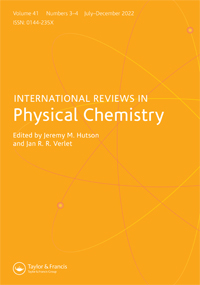Dynamic dipole polarizabilities of heteronuclear alkali dimers: optical response, trapping and control of ultracold molecules
IF 2.5
2区 化学
Q3 CHEMISTRY, PHYSICAL
引用次数: 25
Abstract
Abstract In this article we address the general approach for calculating dynamical dipole polarizabilities of small quantum systems, based on a sum-over-states formula involving in principle the entire energy spectrum of the system. We complement this method by a few-parameter model involving a limited number of effective transitions, allowing for a compact and accurate representation of both the isotropic and anisotropic components of the polarizability. We apply the method to the series of ten heteronuclear molecules composed of two of (Li,Na,K,Rb,Cs) alkali-metal atoms. We rely on both up-to-date spectroscopically-determined potential energy curves for the lowest electronic states, and on our systematic studies of these systems performed during the last decade for higher excited states and for permanent and transition dipole moments. Such a compilation is timely for the continuously growing researches on ultracold polar molecules. Indeed the knowledge of the dynamic dipole polarizabilities is crucial to model the optical response of molecules when trapped in optical lattices, and to determine optimal lattice frequencies ensuring optimal transfer to the absolute ground state of initially weakly-bound molecules. When they exist, we determine the so-called ‘magic frequencies’ where the ac-Stark shift and thus the viewed trap depth, is the same for both weakly-bound and ground-state molecules.异核碱二聚体的动态偶极极化:超冷分子的光学响应、捕获和控制
在本文中,我们讨论了计算小量子系统动态偶极极化率的一般方法,该方法基于一个原则上涉及系统整个能谱的态和公式。我们通过一个涉及有限数量有效跃迁的少参数模型来补充该方法,从而可以紧凑而准确地表示极化率的各向同性和各向异性成分。我们将该方法应用于由两个(Li,Na,K,Rb,Cs)碱金属原子组成的十个异核分子的序列。我们依靠最新的光谱确定的最低电子态的势能曲线,以及我们在过去十年中对这些系统进行的高激发态和永久和跃迁偶极矩的系统研究。这样的编撰对于不断发展的超冷极性分子的研究是及时的。事实上,动态偶极极化率的知识对于模拟被困在光学晶格中的分子的光学响应,以及确定最佳晶格频率,确保最初弱束缚分子的最佳转移到绝对基态至关重要。当它们存在时,我们确定了所谓的“神奇频率”,即交流斯塔克位移和可见陷阱深度,对于弱束缚和基态分子都是相同的。
本文章由计算机程序翻译,如有差异,请以英文原文为准。
求助全文
约1分钟内获得全文
求助全文
来源期刊
CiteScore
14.20
自引率
1.60%
发文量
5
审稿时长
1 months
期刊介绍:
International Reviews in Physical Chemistry publishes review articles describing frontier research areas in physical chemistry. Internationally renowned scientists describe their own research in the wider context of the field. The articles are of interest not only to specialists but also to those wishing to read general and authoritative accounts of recent developments in physical chemistry, chemical physics and theoretical chemistry. The journal appeals to research workers, lecturers and research students alike.

 求助内容:
求助内容: 应助结果提醒方式:
应助结果提醒方式:


